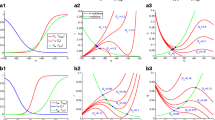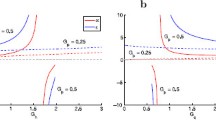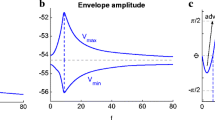Abstract
We investigate the biophysical and dynamic mechanisms of generation of subthreshold amplitude and phase resonance in response to sinusoidal input currents in two-dimensional models of quadratic type. These models feature a parabolic voltage nullcline and a linear nullcline for the recovery gating variable, capturing the interplay of the so-called resonant currents (e.g., hyperpolarization-activated mixed-cation inward and slow potassium) and amplifying currents (e.g., persistent sodium) in biophysically realistic parameter regimes. These currents underlie the generation of resonance in medial entorhinal cortex layer II stellate cells and CA1 pyramidal cells. We show that quadratic models exhibit nonlinear amplifications of the voltage response to sinusoidal inputs in the resonant frequency band. These are expressed as an increase in the impedance profile as the input amplitude increases. They are stronger for values positive than negative to resting potential and are accompanied by a shift in the phase profile, a decrease in the resonant and phase-resonant frequencies, and an increase in the sharpness of the voltage response. These effects are more prominent for smaller values of 𝜖 (larger levels of the time scale separation between the voltage and the resonant gating variable) and for values of the resting potential closer to threshold for spike generation. All other parameter fixed, as 𝜖 increases the voltage response becomes “more linear”; i.e., the nonlinearities are present, but “ignored”. In addition, the nonlinear effects are strongly modulated by the curvature of the parabolic voltage nullcline (partially reflecting the effects of the amplifying current) and the slope of the resonant current activation curve. Following the effects of changes in the biophysical conductances of realistic conductance-based models through the parameters of the quadratic model, we characterize the qualitatively different effects that resonant and amplifying currents have on the nonlinear properties of the voltage response. We identify different classes of resonant currents, represented by h- and slow potassium, according to whether they enhance (h-) or attenuate (slow potassium) the nonlinear effects. Finally, we use dynamical systems tools to investigate the dynamic mechanisms of generation of resonance and phase-resonance. We show that the nonlinear effects on the voltage response (e.g., amplification of the voltage response in the resonant frequency band and shifts in the resonant and phase-resonant frequencies) result from the ability of limit cycle trajectories to follow the unstable (right) branch of the voltage nullcline for a significant amount of time. This is a canard-related mechanism that has been shown to underlie the generation of intrinsic subthreshold oscillations in quadratic type models such as medial entorhinal cortex stellate cells. Overall, our results highlight the complexity of the voltage response to oscillatory inputs in nonlinear models and the roles that resonant and amplifying currents have in shaping these responses.
















Similar content being viewed by others
References
Acker, C.D., Kopell, N., White, J.A. (2003). Synchronization of strongly coupled excitatory neurons: relating network behavior to biophysics. Journal of Computational Neuroscience, 15, 71–90.
Boehlen, A., Heinemann, U., Henneberger, C. (2011). Heterogeneous voltage dependence of interneuron resonance in the hippocampal stratum radiatum of adult rats. Synapse, 65, 1378–1381.
Boehlen, A., Heinemann, U., Erchova, I. (2010). The range of intrinsic frequencies represented by medial entorhinal cortex stellate cells extends with age. Journal of Neuroscience, 30, 4585–4589.
Boehlen, A., Henneberger, C., Heinemann, U., Erchova, I. (2013). Contribution of near-threshold currents to intrinsic oscillatory activity in rat medial entorhinal cortex layer II stellate cells. Journal of Neurophysiology, 109, 445–463.
Buzsáki, G. (2006). Rhythms of the brain. London: Oxford University Press.
Buzsáki, G., & Draguhn, A. (2004). Neuronal oscillations in cortical networks. Science, 304, 1926–1929.
Chorev, E., Yarom, Y., Lampl, I. (2007). Rhythmic episodes of subthreshold membrane potential oscillations in the rat inferior olive nuclei in vivo. Journal of Neuroscience, 27, 5043–5052.
D’Angelo, E., Koekkoek, S.K.E., Lombardo, P., Solinas, S., Ros, E., Garrido, J., Schonewille, M., De Zeeuw, C.I. (2009). Timing in the cerebellum: oscillations and resonance in the granular layer. Neuroscience, 162, 805–815.
Dickson, C.T., Magistretti, J., Shalinsky, M., Hamam, B., Alonso, A.A. (2000). Oscillatory activity in entorhinal neurons and circuits. Annals of the New York Academy of Sciences, 911, 127–150.
Engel, T.A., Schimansky-Geier, L., Herz, A.V., Schreiber, S., Erchova, I. (2008). Subthreshold membrane-potential resonances shape spike-train patterns in the entorhinal cortex. Journal of Neurophysiology, 100, 1576–1588.
Erchova, I., Kreck, G., Heinemann, U., Herz, A.V.M. (2004). Dynamics of rat entorhinal cortex layer II and III cells: characteristics of membrane potential resonance at rest predict oscillation properties near threshold. Journal of Physiology, 560, 89–110.
Gastrein, P., Campanac, E., Gasselin, C., Cudmore, R.H., Bialowas, A., Carlier, E., Fronzaroli-Molinieres, L., Ankri, N., Debanne, D. (2011). The role of hyperpolarization-activated cationic current in spike-time precision and intrinsic resonance in cortical neurons in vitro. Journal of Physiology, 589, 3753–3773.
Giocomo, L.M., & Hasselmo, M.E. (2008). Time constants of h current in layer ii stellate cells differ along the dorsal to ventral axis of medial entorhinal cortex. Journal of Neuroscience, 28, 9414–9425.
Giocomo, L.M., Zilli, E.A., Fransén, E., Hasselmo, M.E. (2007). Temporal frequency of subthreshold oscillations scales with entorhinal grid cell field spacing. Science, 315, 1719–1722.
Gray, C.M. (1994). Synchronous oscillations in neuronal systems: mechanisms and functions. Journal of Computational Neuroscience, 1, 11–38.
Gutfreund, Y., Yarom, Y., Segev, I. (1995). Subthreshold oscillations and resonant frequency in guinea pig cortical neurons: physiology and modeling. Journal of Physiology, 483, 621–640.
Haas, J.S., & White, J.A. (2002). Frequency selectivity of layer II stellate cells in the medial entorhinal cortex. Journal of Neurophysiology, 88, 2422–2429.
Heys, J.G., Giacomo, L.M., Hasselmo, M.E. (2010). Cholinergic modulation of the resonance properties of stellate cells in layer II of the medial entorhinal. Journal of Neurophysiology, 104, 258–270.
Heys, J.G., Schultheiss, N.W., Shay, C.F., Tsuno, Y., Hasselmo, M.E. (2012). Effects of acetylcholine on neuronal properties in entorhinal cortex. Frontiers in Behavioral Neuroscience, 6, 32.
Hodgkin, A.L., & Huxley, A.F. (1952). A quantitative description of membrane current and its application to conductance and excitation in nerve. Journal of Physiology, 117, 500–544.
Hu, H., Vervaeke, K., Graham, J.F., Storm, L.J. (2009). Complementary theta resonance filtering by two spatially segregated mechanisms in CA1 hippocampal pyramidal neurons. Journal of Neuroscience, 29, 14472–14483.
Hu, H., Vervaeke, K., Storm, J.F. (2002). Two forms of electrical resonance at theta frequencies generated by M-current, h-current and persistent Na+ current in rat hippocampal pyramidal cells. Journal of Physiology, 545 (3), 783–805.
Hutcheon, B., Miura, R.M., Puil, E. (1996). Models of subthreshold membrane resonance in neocortical neurons. Journal of Neurophysiology, 76, 698–714.
Hutcheon, B., Miura, R.M., Puil, E. (1996). Subthreshold membrane resonance in neocortical neurons. Journal of Neurophysiology, 76, 683–697.
Hutcheon, B., Miura, R.M., Yarom, Y., Puil, E. (1994). Low threshold calcium current and resonance in thalamic neurons: a model of frequency preference. Journal of Neurophysiology, 71, 583– 594.
Hutcheon, B., & Yarom, Y. (2000). Resonance, oscillations and the intrinsic frequency preferences in neurons. Trends in Neurosciences, 23, 216–222.
Izhikevich, E. (2006). Dynamical Systems in Neuroscience: The geometry of excitability and bursting. Cambridge: MIT Press.
Izhikevich, E.M. (2010). Hybrid spiking models. Philosophical Transactions of the Royal Society A, 368, 5061–5070.
Izhikevich, E.M. (2003). Simple model of spiking neuron. IEEE Transactions of Neural Networks, 14, 1569–1572.
Jalics, J., Krupa, M., Rotstein, H.G. (2010). A novel mechanism for mixed-mode oscillations in a neuronal model. Dynamical Systems: an International Journal, 25, 445–482.
Kaper, T.J., Kramer, M.A., Rotstein, H.G. (2013). Introduction to the focus issue: rhythms and dynamic transitions in neurological disease: modeling, computation, and experiment. Chaos, 23, 046001.
Kispersky, T., White, J.A., Rotstein, H.G. (2010). The mechanism of abrupt transition between theta and hyperexcitable spiking activity in medial entorhinal cortex layer II stellate cells. PLoS ONE, 5, e13697.
Lampl, I, & Yarom, Y. (1993). Subthreshold oscillations of the membrane potential: a functional synchronizing and timing device. Journal of Neurophysiology, 70, 2181–2186.
Lampl, I, & Yarom, Y. (1997). Subthreshold oscillations and resonant behaviour: two manifestations of the same mechanism. Neuron, 78, 325–341.
Ledoux, E., & Brunel, N. (2011). Dynamics of networks of excitatory and inhibitory neurons in response to time-dependent inputs. Frontiers Comparative Neurosciences, 5, 1–17.
Leung, L.S., & Yu, H.W. (1998). Theta-frequency resonance in hippocampal CA1 neurons in vitro demonstrated by sinusoidal current injection. Journal of Neurophysiology, 79, 1592– 1596.
Llinás, R.R., & Yarom, Y. (1986). Oscillatory properties of guinea pig olivary neurons and their pharmachological modulation: an in vitro study. Journal of Physiology, 376, 163–182.
Marcelin, B., Becker, A., Migliore, M., Esclapez, M., Bernard, C. (2009). h channel-dependent deficit of theta oscillation resonance and phase shift in temporal lobe epilepsy. Neurobiology of Disease, 33, 436–447.
Marder, E., & Calabrese, R.L. (1996). Principles of rhythmic motor pattern generation. Physiological Reviews, 76, 687– 717.
Morin, F., Haufler, D., Skinner, F.K., Lacaille, J.-C. (2010). Characterization of voltage-gated K+ currents contributing to subthreshold membrane potential oscillations in hippocampal CA1 interneurons. Journal of Neurophysiology, 103, 3472– 3489.
Muresan, R., & Savin, C. (2007). Resonance or integration? self-sustained dynamics and excitability of neural microcircuits. Journal of Neurophysiology, 97, 1911–1930.
Narayanan, R., & Johnston, D. (2007). Long-term potentiation in rat hippocampal neurons is accompanied by spatially widespread changes in intrinsic oscillatory dynamics and excitability. Neuron, 56, 1061–1075.
Narayanan, R., & Johnston, D. (2008). The h channel mediates location dependence and plasticity of intrinsic phase response in rat hippocampal neurons. Journal of Neuroscience, 28, 5846– 5850.
Nolan, M.F., Dudman, J.T., Dodson, P.D., Santoro, B. (2007). Hcn1 channels control resting and active integrative properties of stellate cells from layer II of the entorhinal cortex. Journal of Neuroscience, 27, 12440–12551.
Pike, F.G., Goddard, R.S., Suckling, J.M., Ganter, P., Kasthuri, N., Paulsen, O. (2000). Distinct frequency preferences of different types of rat hippocampal neurons in response to oscillatory input currents. Journal of Physiology, 529, 205–213.
Puil, E., Gimbarzevsky, B., Miura, R.M. (1986). Quantification of membrane properties of trigeminal root ganglions in guinea pigs. Journal of Neurophysiology, 55, 995–1016.
Puil, E., Meiri, H., Yarom, Y. (1994). Resonant behavior and frequency preferences of thalamic neurons. Journal of Neurophysiology, 71, 575–582.
Reboreda, A., Sanchez, E., Romero, M., Lamas, J.A. (2003). Intrinsic spontaneous activity and subthreshold oscillations in neurones of the rat dorsal column nuclei in culture. Journal of Physiology, 551, 191–205.
Remme, M.W.H., & Rinzel, J. (2010). Role of active dendritic conductances in subthreshold input integration. Journal of Computational Neuroscience, 31, 13–30.
Richardson, M.J.E., Brunel, N., Hakim, V. (2003). From subthreshold to firing-rate resonance. Journal of Neurophysiology, 89, 2538–2554.
Rotstein, H.G. (2014). Frequency preference response to oscillatory inputs in two-dimensional neural models: a geometric approach to subthreshold amplitude and phase resonance. Journal of Mathematical Neuroscience, 4, 11.
Rotstein, H.G., Coombes, S., Gheorghe, A.M. (2012). Canard-like explosion of limit cycles in two-dimensional piecewise-linear models of FitzHugh-Nagumo type. SIAM Journal on Applied Dynamical Systems, 11, 135–180.
Rotstein, H.G., & Nadim, F. (2014). Interaction between resonant and amplifying currents in two-dimensional neural models of frequency preference response to oscillatory input currents. Journal of Computational Neuroscience, 37, 9–28.
Rotstein, H.G., & Nadim, F. (2007). Neurons and neural networks: Computational models. In: Encyclopedia of Life Sciences (Vol. a0000089, pp. 1–9). Chichester:John Wiley. 10.1002/9780470015902.a0000089.pub2.
Rotstein, H.G., Oppermann, T., White, J.A., Kopell, N. (2006). A reduced model for medial entorhinal cortex stellate cells: subthreshold oscillations, spiking and synchronization. Journal of Computational Neuroscience, 21, 271–292.
Rotstein, H.G., Wechselberger, M., Kopell, N. (2008). Canard induced mixed-mode oscillations in a medial entorhinal cortex layer II stellate cell model. SIAM Journal on Applied Dynamical Systems, 7, 1582–1611.
Schmitz, D., Gloveli, T., Behr, J., Dugladze, T., Heinemann, U. (1998). Subthreshold membrane potential oscillations in neurons of deep layers of the entorhinal cortex. Neuron, 85, 999–1004.
Schreiber, S., Erchova, I, Heinemann, U., Herz, A.V. (2004). Subthreshold resonance explains the frequency-dependent integration of periodic as well as random stimuli in the entorhinal cortex. Journal of Neurophysiology, 92, 408– 415.
Schreiber, S., Samengo, I., Herz, A.V. (2009). Two distinct mechanisms shape the reliability of neural responses. Journal of Neurophysiology, 101, 2239–2251.
Solinas, S., Forti, L., Cesana, E., Mapelli, J., De Schutter, E., D’Angelo, E. (2007). Fast-reset of pacemaking and theta-frequency resonance in cerebellar Golgi cells: simulations of their impact in vivo. Frontiers in Cellular Neuroscience, 1, 4.
Stark, E., Eichler, R., Roux, L., Fujisawa, S., Rotstein, H.G., Buzski, G. (2013). Inhibition-induced theta resonance in cortical circuits. Neuron, 80, 1263–1276.
Tohidi, V., & Nadim, F. (2009). Membrane resonance in bursting pacemaker neurons of an oscillatory network is correlated with network frequency. Journal of Neuroscience, 6427, 6435.
Traub, R.D., Jefferys, J.G.R., Whittington, M.A. (1999). Fast oscillations in cortical circuits. Cambridge: MIT Press.
Tseng, H., & Nadim, F. (2010). The membrane potential waveform on bursting pacemaker neurons is a predictor of their preferred frequency and the network cycle frequency. Journal of Neuroscience, 30, 10809–10819.
Wang, W.T., Wan, Y.H., Zhu, J.L., Lei, G.S., Wang, Y.Y., Zhang, P., Hu, S.J. (2006). Theta-frequency membrane resonance and its ionic mechanisms in rat subicular pyramidal neurons. Neuroscience, 140, 45–55.
Wang, X.J. (2010). Neurophysiological and computational principles of cortical rhythms in cognition. Physiological Review, 90, 1195–1268.
Wu, N., Hsiao, C.-F., Chandler, S.H. (2001). Membrane resonance and subthreshold membrane oscillations in mesencephalic v neurons: participants in burst generation. Journal of Neuroscience, 21, 3729–3739.
Yan, Z.-Q., Liu, S.-M., Li, J., Wang, Y., Gao, L., Xie, R.-G., Xue, W.-N., Zhang, G.-L., Zhu, J.-L., Gao, G.-D. (2012). Membrane resonance and its ionic mechanisms in rat subthralamic nucleus neurons. Neuroscience Letters, 506, 160– 165.
Yoshida, M., & Alonso, A. (2007). Cell-type-specific modulation of intrinsic firing properties and subthreshold membrane oscillations by the M(Kv7)-currents in neurons of the entorhinal cortex. Journal of Neurophysiology, 98, 2779–2994.
Zemankovics, R., Káli, S., Paulsen, O., Freund, T.F., Hájos, N. (2010). Differences in subthershold resonance of hippocampal pyramidal cells and interneurons: the role of h-current and passive membrane characteristics. Journal of Physiology, 588, 2109–2132.
Acknowledgments
This project was initiated while the author was affiliated with Boston University (Department of Mathematics and the Center for BioDynamics). The author is grateful to Nancy Kopell for useful discussions during the initial phase of the project and comments on the manuscript, and to Farzan Nadim, David Fox and Yinbo Chen for useful comments. This work was partially supported by the National Science Foundation grant DMS-1313861 (HGR).
Conflict of interest
The author declares that he has no conflict of interest
Author information
Authors and Affiliations
Corresponding author
Additional information
Action Editor: A. Compte
Appendix: Model functions
Appendix: Model functions
Below we present the activation/inactivation curves x ∞ (V) and voltage-dependent time scales τ x (V) used in the kinetic (3) for the gating variables x corresponding to the various models presented in Section 2.1.
1.1 A.1 HNap model 1
1.2 A.2 KsNap model
Rights and permissions
About this article
Cite this article
Rotstein, H.G. Subthreshold amplitude and phase resonance in models of quadratic type: Nonlinear effects generated by the interplay of resonant and amplifying currents. J Comput Neurosci 38, 325–354 (2015). https://doi.org/10.1007/s10827-014-0544-2
Received:
Revised:
Accepted:
Published:
Issue Date:
DOI: https://doi.org/10.1007/s10827-014-0544-2




